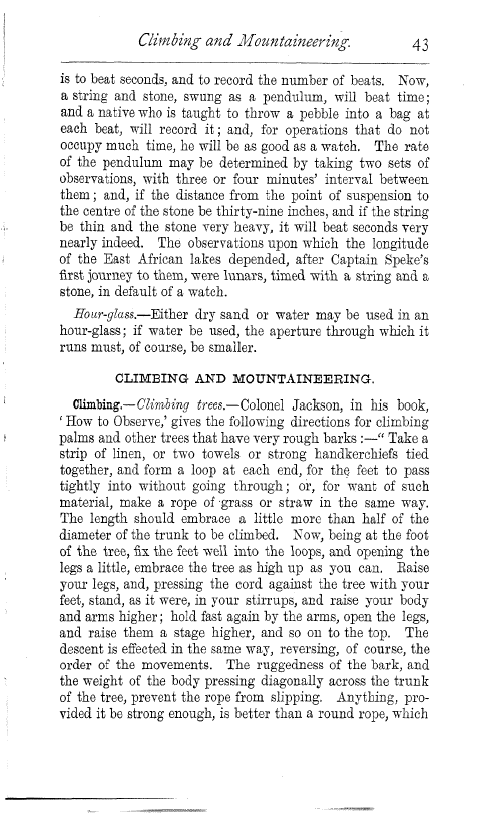Climbing and Mountaineering
43
is to beat seconds, and to record the number of beats. Now, a string and stone, swung as a pendulum, will beat time ; and a native who is taught to throw a pebble into a bag at each beat, will record it ; and, for operations that do not occupy much time, he will be as good as a watch. The rate of the pendulum may be determined by taking two sets of observations, with three or four minutes' interval between them ; and, if the distance from the point of suspension to the centre of the stone be thirty-nine inches, and if the string be thin and the stone very heavy, it will beat seconds very nearly indeed. The observations upon which the longitude of the East African lakes depended, after Captain Speke's first journey to them, were lunars, timed with a string and a stone, in default of a watch.
Hour-glass.-Either dry sand or water may be used in an hour-glass ; if water be used, the aperture through which it runs must, of course, be smaller.
CLIMBING AND MOUNTAINEERING.
Climbing.- Climbing trees.-Colonel Jackson, in his book, `How to Observe,' gives the following directions for climbing palms and other trees that have very rough barks:-" Take a strip of linen, or two towels or strong handkerchiefs tied together, and form a loop at each end, for the feet to pass tightly into without going through ; or, for want of such material, make a rope of grass or straw in the same way. The length should embrace a little more than half of the diameter of the trunk to be climbed. Now, being at the foot of the tree, fix the feet -well into the loops, and opening the legs a little, embrace the tree as high up as you can. Raise your legs, and, pressing the cord against the tree with your feet, stand, as it were, in your stirrups, and raise your body and arms higher ; hold fast again by the arms, open the legs, and raise them a stage higher, and so on to the top. The descent is effected in the same way, reversing, of course, the order of the movements. The ruggedness of the bark, and the weight of the body pressing diagonally across the trunk of the tree, prevent the rope from slipping. Anything, provided it be strong enough, is better than a round rope, which

